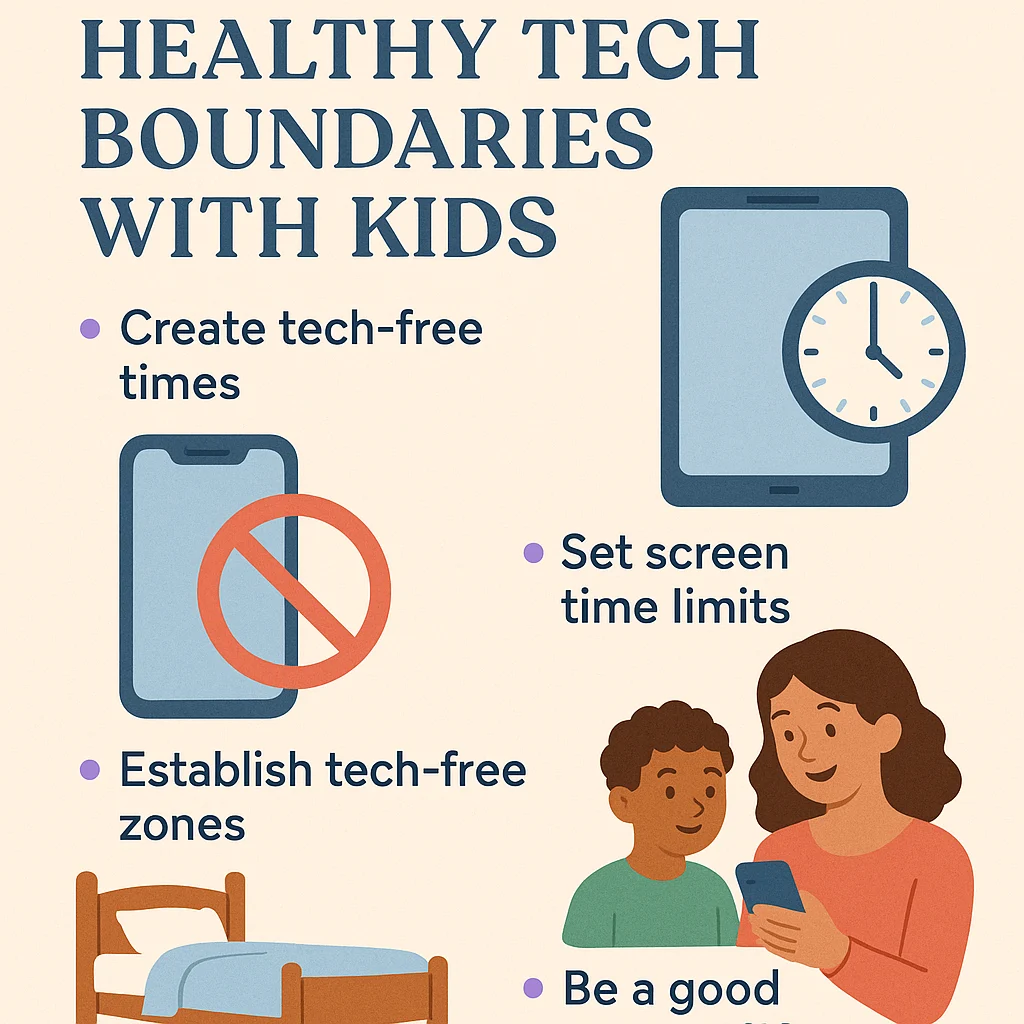Amidst the prevalence of screens on phones, tablets, TVs, gaming consoles, and laptops, parenting in the digital age has become a delicate balancing act. Although there are many advantages to technology, such as educational applications and video calls with family, excessive or unsupervised use can result in a variety of behavioral, social, and developmental problems. Instead of completely banning technology, the answer is to set up sensible limits that let children benefit from it without becoming victims of its drawbacks.
This blog examines useful tactics, professional guidance, and doable suggestions for establishing family-friendly tech boundaries.
Why Setting Tech Boundaries Is Important
Before diving into how to create tech boundaries, it's essential to understand why they matter.
1. Mental and Emotional Health
Children's attention spans, anxiety, and sleep issues have all been related to excessive screen time. Teenagers' perceptions of their bodies and self-worth can be adversely affected by social media in particular.
2. Physical Health
Obesity and bad posture are caused by sedentary behavior linked to excessive device use. By interfering with circadian rhythms, blue light from screens can also have an impact on sleep patterns.
3. Academic Performance
Children who use screens more frequently tend to do worse academically. Multitasking between digital entertainment and homework can impair concentration and memory.
4. Social Development
Face-to-face interaction is essential for the development of empathy, communication, and emotional intelligence, all of which are negatively impacted when a child's world is dominated by screens.
Understand Your Child’s Tech Landscape
Learn how your child uses technology before establishing rules. Pose queries such as:
-
What apps or games do they like?
-
Who are they interacting with online?
-
What websites or YouTube channels do they watch regularly?
This demonstrates your interest in your child's world while also assisting you in setting more sensible boundaries.
How Much Screen Time Is Too Much?
The American Academy of Pediatrics (AAP) recommends:
-
Under 18 months: Avoid screen time except for video chatting.
-
18-24 months: Limit to high-quality educational content, co-watched with parents.
-
2-5 years: No more than 1 hour per day of high-quality programming.
-
6 years and up: Establish regular boundaries to guarantee time for rest, exercise, and other healthful pursuits.
Use these guidelines as a baseline, not a strict rule — each child and family is different.
1. Establish Screen-Free Zones
Encouraging healthier habits is facilitated by setting aside particular locations and times for screen time.
-
No devices at the dinner table: This encourages communication and family bonding.
-
No screens in bedrooms: It helps ensure better sleep and reduces temptation.
-
Create tech-free time blocks: For example, no screens one hour before bedtime.
2. Model Good Behavior
Youngsters are more likely to imitate adult behavior than adhere to rules. Constantly using your phone or watching TV conveys conflicting messages. Be deliberate:
-
Keep your phone away during meals.
-
Limit your own screen time when with kids.
-
Let them see you read books or engage in offline hobbies.
Tech boundaries start with you.
3. Set Clear and Consistent Rules
Be specific in your warnings rather than general ones like "don't use your tablet too much." A few instances are:
-
“You can play video games for 30 minutes after homework is done.”
-
“No YouTube after 7 PM.”
-
“On weekends, you get 2 hours total of screen time.”
Display these guidelines on a whiteboard or chart. The secret is consistency. When children know exactly what to expect, they react better.
4. Use Parental Controls Wisely
Most devices and apps offer robust parental controls. These can help:
-
Set daily screen time limits.
-
Block inappropriate content.
-
Monitor activity (especially for younger kids).
-
Restrict in-app purchases or downloads.
Without spying or micromanaging, you can establish a safer online environment with the aid of programs like YouTube Kids, Apple Screen Time, and Google Family Link.
5. Encourage Tech With Purpose
Screen time is not all the same. An educational math game and endless TikTok scrolling are very different. Promote "active" rather than "passive" tech use:
-
Educational apps like Duolingo, Khan Academy, or PBS Kids.
-
Creative tools like Toca Boca, drawing apps, or coding platforms like Scratch.
-
Video chatting with family instead of random YouTube videos.
When screen time is meaningful, it’s easier to justify — and easier to manage.
6. Have Open Conversations About Tech
Discuss the rationale behind your limit-setting with your children. Children are more likely to respect rules when they know why they are in place.
You can say things like:
-
“Too much screen time can hurt your eyes and make it hard to sleep.”
-
“It’s important to balance screens with physical play and real conversations.”
-
“We’re trying to protect your brain, not punish you.”
Encourage them to express their thoughts as well. When you include them in the process, you may be surprised at how mature their responses can be.
7. Create a Family Media Plan
A media plan is a written or agreed-upon structure outlining how technology is used in your home. This might include:
-
Time limits by age or day
-
Rules for homework and gaming
-
Family tech-free zones
-
Expectations for social media or texting
To create a family media plan that suits your needs, you can even use the AAP's free online tool.
8. Reward Balance, Not Abstinence
Praise your child for engaging in non-screen activities, such as reading, riding a bike, or playing outside, rather than using technology as a reward or a punishment.
You can say:
-
“I love how you spent the afternoon drawing instead of being on your tablet.”
-
“Thanks for turning off the TV when it was time for dinner without being asked.”
This reinforces balance, not avoidance.
9. Be Flexible — But Not Too Flexible
Life is ever-changing. It may be necessary to break the rules on sick days, lengthy car trips, or special family movie evenings. It's alright.
Avoid making a "one-time exception" every day, though. As much as possible, stay within your bounds, and when you do deviate, explain why.
10. Stay Updated on Trends
Technology changes fast. What’s popular today may be obsolete next year. Stay aware of:
-
New apps or games your child may want
-
Online slang or trends that could include risky behavior
-
News on digital safety, such as data privacy or harmful challenges
Join parenting forums or subscribe to newsletters like Common Sense Media to stay informed.
Final Thoughts: Balance Is the Goal
To raise tech-savvy children, you don't have to be anti-technology. It all comes down to helping your kids form a positive relationship with technology so they can reap its advantages while maintaining a sense of reality.
Healthy tech boundaries are not a one-time rule; they are a lifelong process. Your boundaries will change as your children's needs change over time. Be involved, caring, and consistent.
Because at the end of the day, technology shouldn’t raise your kids — you should.




Leave a Reply